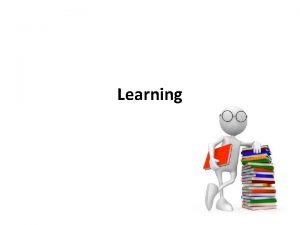Learning Styles A Guide Learning styles guide the








- Slides: 8

Learning Styles: A Guide Learning styles guide the way you learn. Research shows us that each learning style uses different parts of the brain. For example, the right temporal lobe is especially important for music. Each person learns in different ways, and recognizing this can help you be more successful in different arenas (school, work, etc. ).

Visual Prefer using pictures, images, and spatial understanding. Tips for visual learners: Make picture flashcards Draw in your notes Use different colored pens/markers Use maps and draw storyboards Draw webs and outlines for organizing Use a whiteboard in your room Keep a set of markers, colored pencils, or crayons with you. Visualize what you want to do in your mind’s eye

Aural Prefer using sound and music. Tips for Aural Learners: Listen to music while studying Write jingles to remember content Use tunes you already know to remember new content Read aloud with study partners Use books on tape Tape lectures with a recorder for later Talk through problems

Verbal Prefer using words, both in speech and writing. Tips for Verbal Learners: Talk through problems Read aloud to yourself and to others Use rhymes to remember things Take copious notes Write down things you need to remember Keep a daily log book or journal Debate topics with friends Use the dictionary to find new words

Physical Prefer using your body, hands and sense of touch. Tips for Physical Learners: Take a small, quiet toy to hold in classes where there is not a lot of movement Set up experiments to use what you’ve learned Read on a treadmill or stationary bike Record lectures to re-listen while working out Get involved when there is an opportunity Take classes where hands-on learning is the norm

Logical Prefer using logic, reasoning and systems. Tips for Logical Learners: Use charts and graphs Create agendas or to-do lists when studying Rank what you need to do in order of importance Use an organizer for homework and classwork Play logic games and do brain-teasers Be careful not to over-do the computer/video games (Set a time limit, as you can get carried away) Look for patterns in what you are learning List the rules or procedures with what you are doing

Social Prefer to learn in groups or with other people. Tips for Social Learners: Create study groups Mentor others in your areas of strength Work in groups when given the opportunity Bounce ideas off of other people Show your homework to a friend or parent Meet with your teacher after school When you feel stuck, ask for others’ ideas Get together with friends to do homework

Solitary Prefer to work alone and use self-study. Tips for Solitary Learners: Make time for yourself to reflect Keep a log or journal of events Create a space where you will not be bothered Work alone when given the opportunity When working with groups, try to carve out your own niche or area to work Work on personal hobbies Make plans















